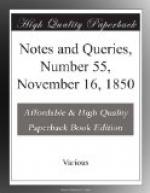22. London Spa (from which Spa Fields derives its name) dates as far back as 1206. In the eighteenth century, it was a celebrated place of amusement. There is a curious view of “London Spaw” in a rare pamphlet entitled May-Day, or, The Original of Garlands. Printed for J. Roberts, 1720, 8vo.
23. Spring Gardens.—Cox’s Museum is described in the printed catalogue of 1774, as being in “Spring Gardens.” In the same year a small volume was published containing A Collection of various Extracts in Prose and Verse relative to Cox’s Museum.
24. The Pantheon in Spa Fields.—This place of amusement was opened in 1770 for the sale of tea, coffee, wine, punch, &c. It had an organ, and a spacious promenade and galleries. In 1780 it was converted into a lay-chapel by the Countess of Huntingdon, and is now known as Northampton or Spa Fields Chapel. Mr. Cunningham speaks of the burying-ground (originally the garden), but singularly enough omits to notice the chapel.
25. Baldwin’s Gardens, running between Leather Lane and Gray’s Inn Lane, were, according to a stone which till lately was to have been seen against a corner house, bearing the arms of Queen Elizabeth, named after Richard Baldwin, one of the royal gardeners, who began building here in 1589.
26. Rathbone Place.—In an old print (now before me) dated 1722, this street is called “Rawbone Place.” The Percy coffee-house is still in existence.
27. Surrey Institution, Blackfriars Road.—This building was originally erected, and for some years appropriated to the Leverian Museum. This magnificent museum of natural history was founded by Sir Ashton Lever, who died in 1788. It was afterwards disposed of by way of lottery, and won by Mr. James Parkinson, who transferred it from Leicester Place to the Surrey side of Blackfriars bridge.
28. Schomberg House, Pall Mall, (now, I believe, about to be pulled down), was once the residence of that celebrated “quack” Dr. Graham. Here, in 1783, he erected his Temple of Health. He afterwards removed to Panton Street, Haymarket, where he first exhibited his Earth Bath. I do not find any mention of Graham in Mr. Cunningham’s book.
EDWARD F. RIMBAULT.
* * * * *
FOLK LORE.
Laying a Ghost.—Frequent mention is made of the laying of ghosts, and in many localities the tradition of such an event is extant. At Cumnor, Lady Dudley (Amy Robsart’s) ghost is said to have been laid by nine Oxford parsons, and the tradition is still preserved by the villagers; but nowhere have I been able to ascertain what was the ceremony on such an occasion.
Is anything known on the subject?
A.D.B.
Abingdon, Nov. 1850.




